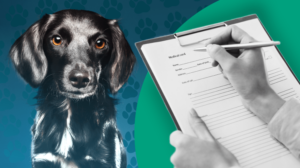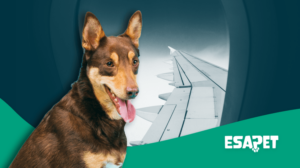Alaska Airlines Pet Policy: Learn How to Fly With Your Pet

Traveling with your pet can be a wonderful experience. It requires careful planning and understanding of Alaska Airlines Pet Policy.
Alaska Airlines offers a range of options for pet travel, whether in a cabin or the checked baggage compartment. Knowing the details of these policies can make your journey smoother and stress-free.
Alaska Airlines Pet Travel Rules
Traveling with pets on Alaska Airlines can be as smooth and comfortable as possible. The airline accommodates both pets and service animals. It ensures they travel safely in the cabin or the checked baggage compartment.
Pets must be small enough to fit in a pet carrier beneath the seat in front of you to fly in the cabin. The carrier must be well-ventilated and large enough for your pet to move around.
For pets flying in the cargo, the airline requires sturdy crates with a secure, all-around locking system. Fees apply for each way per kennel/carrier.
ESAs are not recognized as service animals and must travel as pets, subject to pet travel fees. Service animals can travel at no extra charge. You need proper documentation to confirm the status of service animals. Having the necessary paperwork will help travel without issues.
TLDR: Alaska Airlines provides clear guidelines for pet travel. These pet travel guidelines include carrier requirements, fees, and documentation needed for service animals. Understanding these rules ensures a smooth travel experience for both pets and their owners.
Alaska Airlines Fees for Pet Travels
Fees are applicable per way when traveling with live animals on Alaska Airlines. The fees depend on whether your pet is in the cabin or the cargo compartment.
The fee for cabin travel is $100 USD/CAD each way, which ensures your small pet can accompany you. This fee covers the necessary space and accommodations for safe travel under your seat.
Due to the additional space and handling requirements, the fees are higher for larger pets traveling in cargo. The fee for cargo travel is $150 USD/CAD each way.
This service ensures that the pet safely travels in a climate-controlled baggage environment. This environment is ideal for longer journeys.
Check the specific requirements and fees before booking your flight. This will ensure that you make all preparations for your pet’s comfort and safety during the journey.
ESAs are Exempt from Pet Fees for Housing |
|
According to the FHA, Emotional Support Animals and Service Dogs are exempt from any housing pet fees, deposits or pet rents. |
Alaska Airlines Standards for ESA and Service Animals
Flights operated by Alaska Airlines do not permit emotional support animals (ESAs) to travel in the cabin for free. ESAs are recognized as pets, not service animals, and are subject to pet travel fees for both domestic and international travel.
Service animals, particularly trained service dogs, can travel in the cabin at no extra charge if they meet specific criteria. Proper documentation is required for service animals to confirm their status.
The airline also has strict requirements for the type and size of kennel used for pets traveling. During the flight, the kennel must be of solid construction and soft-sided. The construction can be plastic, wood, or metal. It should have a secure, spring-loaded locking system.
The sizes range from extra small (100) at 15″ x 16″ x 21″ to extra large (500) at 30″ x 27″ x 40″. These specifications ensure that pets are securely contained during the flight. The sizes may vary for other airlines.
Alaska Airlines and the ACAA
Alaska Airlines follows the updated ACAA regulations regarding ESAs. The ACAA no longer requires airlines to accommodate ESAs as service animals, and Alaska Airlines does not permit ESAs to travel in the cabin for free. ESAs must travel as pets and are subject to pet fees.
However, the airline accommodates trained service dogs that meet specific criteria. Passengers traveling with service dogs must provide the U.S. Department of Transportation Service Animal Air Transportation Form.
Service dogs must be well-behaved and under control during the flight. You need to provide required documentation at least 48 hours before departure to ensure a smooth process. These measures ensure a safe and pleasant travel experience for all passengers.
Also, some ESA-friendly airlines do give ESAs many benefits, so you should check them out if this is your preference.
Allowed Support Animals
Below is a detailed list of the types of animals permitted on Alaska Airlines, along with their pet travel options and associated fees.
Animal |
Permitted on |
Fees |
| Small Dogs | Cabin, Cargo | $100 each way (Cabin) |
| Cats | Cabin, Cargo | $100 each way (Cabin) |
| Rabbits | Cabin | $100 each way |
| Household Birds | Cabin | $100 each way |
| Large Dogs | Cabin | Varies by weight |
| Ferrets | Cargo | Varies by weight |
| Guinea Pigs | Cargo | Varies by weight |
| Hamsters | Cargo | Varies by weight |
| Non-poisonous Reptiles | Cargo | Varies by weight |
| Pot-bellied Pigs | Cargo | Varies by weight |
| Tropical Fish | Cargo | Varies by weight |
Notes
- Small Dogs and Cats: Small dogs and cats can travel in the cabin if they fit in an approved pet carrier under the seat. For cargo travel, you need a health certificate issued by a licensed veterinarian.
- Rabbits and Household Birds: Rabbits and birds can travel in the cabin only if they fit in an approved pet carrier under the seat. Poultry and farm birds are not allowed.
- Large Dogs and Other Animals: Large dogs and other animals can travel in the cargo compartment with appropriate health certificates and specific kennel requirements. Fees vary based on the animal’s weight and the kennel’s requirements.
Breed Restrictions on Alaska Airlines
Alaska Airlines has specific breed restrictions. The restriction ensures the safety and well-being of all pets traveling on their flights.
The airline does not accept Brachycephalic or “short-nosed” breeds, such as Bulldogs, Pugs, and Persian cats, for travel in the baggage compartment. The restriction on breeds allowed to fly is due to their increased risk of health issues during flight.
How to Travel with Snub-Nosed Dogs?
Allowed Cat Breeds in Cabin
- Domestic Shorthair
- Domestic Longhair
- Siamese
- Maine Coon
- Ragdoll
- Bengal
- Sphynx
- British Shorthair
- Abyssinian
- American Shorthair
Allowed Dog Breeds in Cabin
- Chihuahua
- Pomeranian
- Yorkshire Terrier
- Shih Tzu
- Dachshund
- Toy Poodle
- Maltese
- Boston Terrier
- Miniature Schnauzer
- Jack Russell Terrier
Alaska Airlines ESA Requirements
Alaska Airlines has clear requirements for passengers traveling with Emotional Support Animals (ESAs) to ensure a smooth travel experience. These requirements help verify the legitimacy of the ESA.
Allowances
- Accepted Animals: Only a cat and dog can travel as an ESA.
- Behavior: ESAs must be well-behaved and remain under control to travel on Alaska Airlines.
- Documentation: Required documentation includes the U.S. Department of Transportation Service Animal Air Transportation Form.
Restrictions
- Documentation Deadline: The owner needs to submit all necessary documentation at least 48 hours before the scheduled departure.
- Breed Restrictions: Brachycephalic dogs and cats are not allowed in the baggage compartment.
- Age Requirements: Dogs and cats must be at least eight weeks old and fully weaned.
- Number of ESAs: The airline allows only one ESA per passenger.
- Carrier Requirements: The combined weight of the pet and carrier must not exceed 150 lbs. Pets and carriers exceeding this weight should use the Pet Connect™ service.
What to Know Before Flying Alaska Airlines With Pets
Flying with pets on Alaska Airlines can be a smooth experience if you’re well-prepared. Understanding the airline’s policies and preparing your pet in advance is key to ensuring a stress-free journey. You need to follow specific guidelines.
First, make sure to reserve a spot for your pet as soon as you finalize your travel plans. Alaska Airlines has a limit on pets allowed in the baggage compartment, and reservations are on a first-come, first-served basis.
Additionally, the combined weight of your pet and carrier must not exceed 150 lbs. If the weight is more than 150 lbs, you’ll need to use their Pet Connect™ service.
For those traveling with ESAs, dogs and cats are the only animals permitted in the cabin. For a smooth experience, submit the necessary documentation at least 48 hours before your flight.
Also, certain breeds prohibited from flying, including short-nosed breeds like Pugs and Persian cats, due to health risks.
Prepping the ESA for Travelling
Here are some best practices to ensure a smooth travel experience with your ESA:
- Health Check: Schedule a vet visit and travel consultation to ensure your ESA is fit for travel. The free office visit can help obtain a health certificate.
- Documentation: Make sure you have all the necessary paperwork, including the U.S. Department of Transportation Service Animal Air Transportation Form to get accepted for travel.
- Familiarize with the Carrier: Introduce your ESA to their pet carrier well in advance to get them accustomed to it.
- Comfort Items: Bring along your pet’s favorite blanket or toy to provide comfort during the flight.
- Feeding: Feed your pet a light meal a few hours before the flight to avoid any discomfort.
- Hydration: Ensure your pet is always hydrated. To prevent accidents, avoid giving too much water right before the flight.
- Exercise: Give your ESA plenty of exercise before the flight to help them relax and sleep during the journey.
- Calm Environment: If your pet is prone to anxiety, use calming sprays or pheromone products. You can also consider mild sedatives prescribed by a vet.
- Travel Essentials: Pack a travel kit with food, water, a bowl, a leash, and waste bags. Give the pet their regular medicine before the flight and bring it along in case the pet get motion sick.
By following these tips, you can help ensure that your ESA remains calm and comfortable during the flight. Following these tips can make the travel experience pleasant for everyone.
Required Forms and Documents for ESAs
Having the right documentation is essential for traveling with an emotional support animal (ESA).
ESA Letter or PSD Letter
An ESA Letter is essential for recognizing your animal as an Emotional Support Animal. You can get an ESA letter from a Licensed Mental Health Professional (LMHP). This letter confirms the necessity of the ESA for your mental health. It helps streamline accommodation processes.
A Psychiatric Service Dog (PSD) Letter is different from an ESA Letter. It applies to a dog that is already trained to perform tasks for individuals with psychiatric disabilities.
PSDs have more extensive rights. These rights include access to places where pets have no entry and fee exemptions under the Fair Housing Act and the Americans with Disabilities Act.
Behavior Form
The Behavior Form is important as it ensures that the ESA can behave in various settings, especially during travel. This form assesses the animal’s temperament and behavior in public spaces.
ESA Pet offers this as an additional service when acquiring an ESA Letter, providing peace of mind that your animal meets behavioral standards. This is important for preventing incidents and ensuring the safety and comfort of all passengers.
Health Form
The Health Form is usually completed by a licensed veterinarian. It certifies that your ESA is healthy and fit for travel. It verifies that the animal is free from diseases and has received all necessary vaccinations, such as a rabies vaccination certificate.
ESA Pet offers this service as part of its package. ESA Pet makes it convenient for you to get all required documentation in one place. Airlines and housing authorities often need a health certificate to ensure the well-being of the ESA and the public.
Getting an Official ESA Letter and Additional Documentation
With ESA Pet, obtaining an ESA Letter is a straightforward process. It helps to officially recognize your emotional support animal. Follow these three simple steps to get your documentation in order.
Step 1: Complete the Simple 2-Minute Screening
Start by taking a short survey where you’ll answer a few simple questions about your mental and emotional health.
This confidential survey helps mental health care providers determine whether you need an Emotional Support Animal (ESA). Rest assured, your responses are secure and only accessible to authorized personnel.
Step 2: Connect With a Licensed Healthcare Professional
After completing the survey and submitting a secure payment, ESA Pet will connect you with a qualified healthcare professional licensed in your state. The professional will assess your mental and emotional health to determine if an ESA would benefit you.
Step 3: Get Your ESA Letter
If approved, the licensed health professional will issue a signed ESA letter. You will receive a digital copy of your ESA Letter within three business days. ESA Pet makes it easy to have the necessary documentation for your ESA.
Get your Official ESA Letter Consultation from a licensed therapist.
Get ESA Letter Now
Alaska Airlines Pet Policy FAQ
How Strict Is Alaska Airlines Pet Policy?
Alaska Airlines has clear pet policies to ensure the safety and comfort of all passengers and pets. They need specific documentation, adherence to size and weight limits, and reservations for the pets in baggage compartment.
How Much Does Alaska Airlines Charge for Pets?
Alaska Airlines charges $100 each way for pets in the cabin. Pets in baggage compartment are subject to different fees and conditions.
Does Alaska Allow Pets in Cabins?
Yes. Alaska Airlines allows small pets in cabin to travel, such as cats, dogs, rabbits, and small birds. They must be in an approved carrier that fits under the seat in front of you.
Can I Buy My Dog a Seat on a Plane?
No. Alaska Airlines does not allow passengers to buy an extra adjacent seat for their pets. Pets must travel either in the main cabin under the seat or in the baggage compartment.
How Do I Add a Pet to My Flight?
To add a pet to your flight, you need to contact Alaska Airlines reservations or chat with their reservations team. It’s important to book early as there is a limit on the number of pets allowed per flight.
Can Emotional Support Dogs Fly on Alaska Airlines?
Emotional Support Dogs can no longer fly for free under the American Carrier Access Act. However, they can still travel as pets in the cabin or cargo, subject to the airline’s pet travel policies and fees.
Wrapping Up Alaska Airlines Pet Policy
Travel on Alaska Airlines can be a smooth and enjoyable experience if you follow their guidelines. We’ve covered the essential points of the Alaska Pet Policy, from the types of pets allowed in the cabin and cargo to the necessary documentation and fees.
Small ESAs like dogs, cats, rabbits, and household birds can travel in the cabin with you. However, they need to be in an approved same carrier.
Larger pets can travel in the cargo compartment. However, be mindful of additional restrictions such as breed restrictions and health requirements.
Make sure to book early, as there are limits on the number of pets allowed per flight. Also, have your paperwork, including a health certificate, in order.





